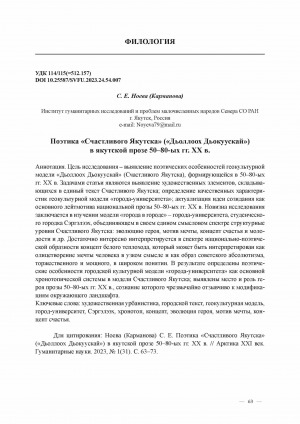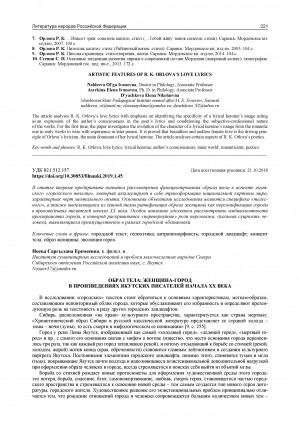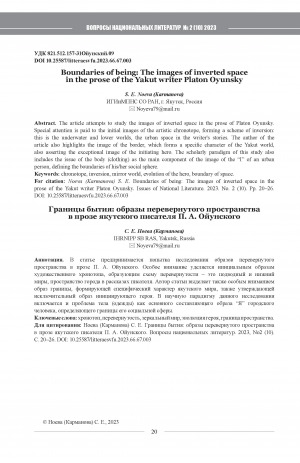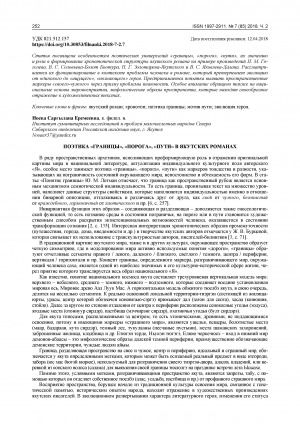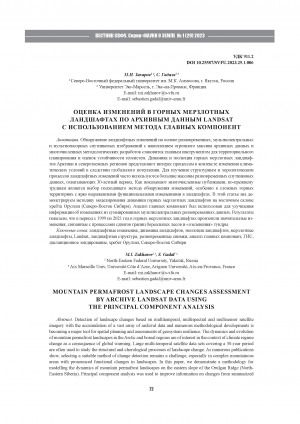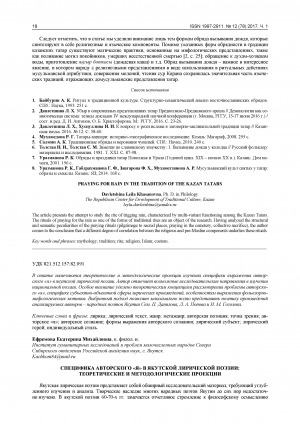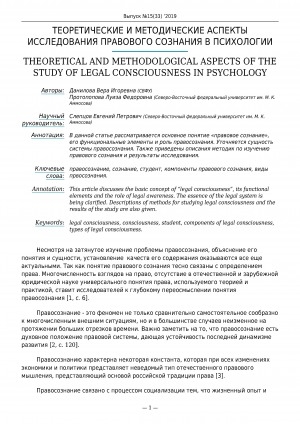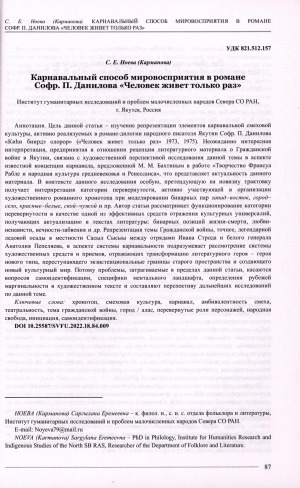Цель данной статьи - исследование художественной репрезентации опыта включения человека в различные пространства, получающей раскрытие в произведениях якутских писателей В.В. Яковлева и Н.А. Лугинова. В частности, выявляется специфика ландшафтного сознания человека-саха, отраженного в оппозиции геопоэгических образов алааса и города. Попытка осмысления этих знаковых геопоэтических образов через проекцию отношений Земли и Неба сформирована историко-культурными представлениями народа о земле как женском теле (Ийэ Сир), а также обусловлена отчасти исследованиями литературоведов и культурологов о городе как небесном образе. Автором представлена достаточно интересная литературоведческая интерпретация, допущенная в отношении городского текста в контексте якутской прозы 70-80-х гг. XX в. Исследовательское внимание автора статьи обращено на характер персонификации геопоэтических образов: специфику олицетворения Земли как женского лона, представленной в качестве влажной, щедрой, плодоносной хтонической материи, и воплощение города-Женщины, гордой и неприступной Госпожи (Дьокуускай Хогун). Выявлены маркеры якутского городского ландшафта - хтод. темнота, просторы, туман. снег, бешй цвет, пыль, грязь, теснота и пр., - определяющие уникальный портрет города Якутска. В качестве одного из первичных признаков данного топологического образа исследователь выделяет призрачность, сформированную при помощи концептов "туман", "снег", "дымка", "мгла", "пыль", активно участвующих при создании всего городского ландшафта. Глубокая связь гротескной концепции, использованная писателями в отношении геопоэтических образов aлаaca и города, представлена в качестве художественной проекции ландшафтного сознания человека, героя якутской прозы XX в.
The aim of this article is to study the artistic representation of the experience of incorporating a person into various spaces, which is revealed in the works of Yakut writers V.V. Yakovlev and N.A. Luginov. In particular, the specificity of the human-Sakha landscape consciousness, reflected in the opposition of the geo-ethical images of Alas and the city, is revealed. The attempt to comprehend these iconic geo-poetic images through the projection of the relations of Earth and Heaven is formed by the historical and cultural ideas of the people about the earth as a woman's body (lye Sir), and is also due in part to studies of literary scholars and cultural scientists about the city as a heavenly image. The author presents a rather interesting literary interpretation, made with respect to the urban text in the context of the Yakut prose of the 70-80s. Twentieth century'. The author's research focuses on the character of the personification of geo-ethical images: the specifics of the personification of the Earth as the female womb, presented as a moist, generous, fruitful chthonic matter, and the embodiment of the city of the Woman, the proud and unapproachable Mistress (Dyokuskai Ilotun). Identified markers of the Yakut urban landscape - cold. dark, open spaces, fog, snow, white color, dust. dirt, crowded, etc., - defining a unique portrait of the city of Yakutsk. As one of the primary features of this topological image, the researcher identifies the ghostlyness formed with the help of the concepts "fog”, “snow”, “haze", “mist", “dust” that are actively involved in creating the entire urban landscape. ‘Hie deep connection of the grotesque concept, used by writers in relation to the geo-poetic images of Alas and the city, is presented as an artistic projection of the landscape consciousness of man, the hero of the Yakut prose of the twentieth century.


